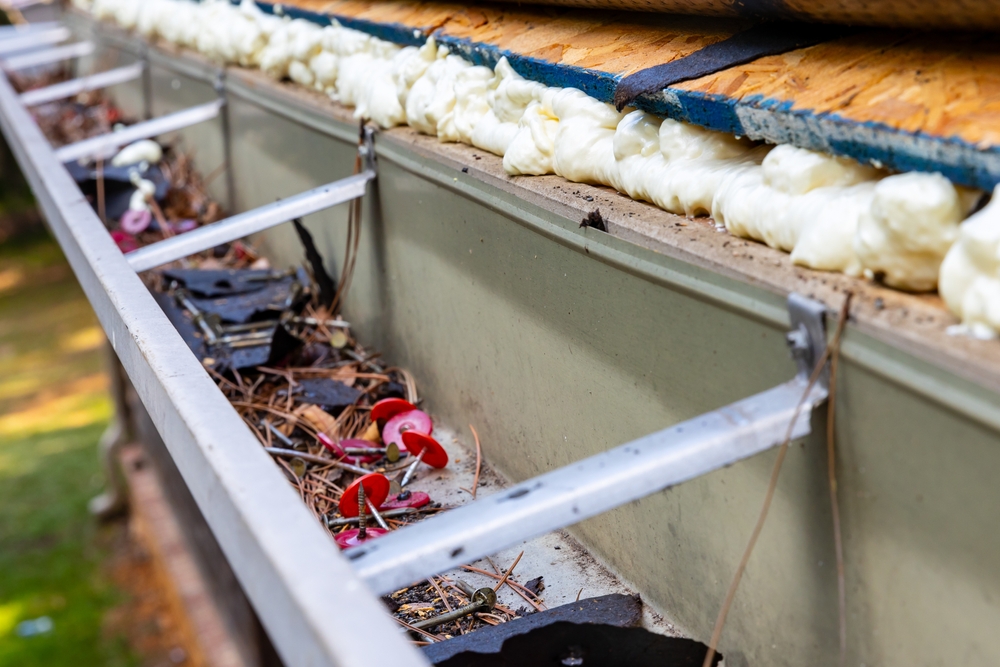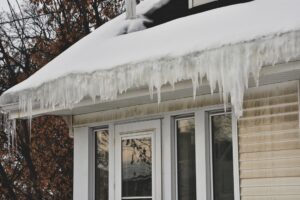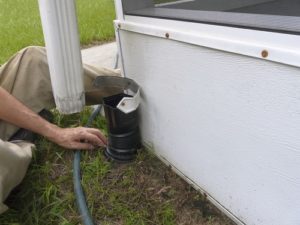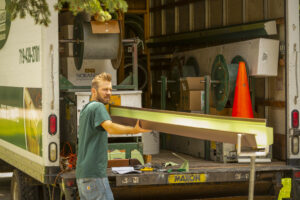
First of all, any sort of foam product that you put in your gutter to prevent clogging will need to be removed, power washed, and reinstalled every few years. It is the same for any brush-style product containing bristles. The foam absorbs the water in the winter and acts like a frozen sponge, trapping water against your fascia and shingle edge as it freezes and thaws. Once the foam is frozen, it provides a platform for ice damming to occur. Moss and seeds from plants tend to germinate and grow in them, and after a few years, the chemicals break down, and it starts to dry rot, so the product you paid so much money for becomes a fire hazard. Why pay for such a nightmare? Foam gutter sponges and brush-style filters create more work and damage for you. You are better off saving your money and cleaning your gutters out by hand because it will be less expensive and less work.
The Drawbacks of Gutter Screens
Screens – There are many different types of screens on the market today. Most are made of either vinyl or metal. If you install any sort of product made of vinyl on top of your gutters in Colorado, it will fry like bacon in the summer sun after a few short years. It will shrink, warp, contort, dry rot, and become brittle. Eventually, the vinyl screen breaks down and crumbles into your gutter, becoming the clog. If the screen is made of metal, it acts like a cheese grater when organic debris rests on top of it and slowly starts to break down. The debris breaks down fine enough to make it through the screen and then solidifies your gutter like a lump of shredded cheese in the bottom. Once that lump of cheese works its way to the downspout, you’ve got a clog. So you have to get up on the ladder, clean the top of your screen, take it off, and clean the shredded cheese out of the bottom of your gutter, too. Why pay money to create all this extra work for yourself? In the winter, the holes in the screen freeze and provide a perfect platform for ice damming. Now, all the weight of the ice is sitting on top of the gutter instead of inside the bottom, making it heavy. Your gutters are much more likely to pull away from your home or start to back-pitch in a short amount of time with a top-heavy screen that’s loaded down with ice and snow. Don’t waste your money on screens; they require more work than no protection. There’s an old saying, “Anything that’s a screen needs to be cleaned.”
Filters: Are They Truly Maintenance-Free?
Filters – Have you ever owned or heard of a filter that never needed cleaning or replacement? I sure haven’t. I changed the air filter in my truck the other day, and yesterday, I changed the air filter in my home HVAC system every two months. Why would you want to pay for a leaf filter in your gutters? Over time, the filter clogs with sap, pollen, and expansive bentonite clay dust from the rain clouds; heaven forbid your LeafFilter is under a pine tree. Sap and pollen do a great job keeping everything out of your gutter, including the water. Eventually, the rainwater will overshoot your system unless you get back up on that ladder and either power wash the filter or scrub it with a brush. Why spend money on a product you still have to clean? Scooping your gutters out without a screen or filter is more accessible and safer. The shape of the base of the Leaf Filter is slightly angled towards the ground to discourage the build-up of organic debris and, in the winter, ice, and snow, but it’s not angled enough to prevent it from happening. The base is also vinyl or brittle plastic, depending on which generation you had installed on your home. Anything that is plastic or vinyl that sits outside, on top of your gutters, in the harsh Colorado elements, will not survive for more than a few years. Why pay money for a solution that isn’t permanent, that you will continually have to clean and break down and need replacing in a few years? No matter how excellent the television commercial is, it makes no sense.
Exploring Gutter Hood Solutions
Hoods are the best gutter protection, especially those that apply reverse curve technology and surface tension. The water washes off your shingle and onto the hood, wrapping around the curve at the edge of the hood and shooting back into your gutter through surface tension. It’s a common law of physics. Stand at your sink, take a glass, turn it horizontally, and turn on your faucet. What happens? Does the water bounce off the glass? No, it wraps around the glass and shoots off the other side. This is surface tension.
Although hoods are the best option, many are on the market today so that you can save time and money. One is the Amerimax vinyl gutter cover that you can find at Home Depot or any other box store for approximately $5 per foot. Why do you not want to waste your money on this product?; it’s made out of vinyl. I can’t make this point any clearer; anything that sits outside in Colorado does not survive for very long. This hood cover slides underneath your first layer of shingles and snaps onto the front of your gutter. After a few summers, it starts to cook in the sun, and it begins to warp. Once it warps, it pops up the first layer of shingles on your roof like flaps on an airplane, exposing your roof decking, ice, and water shield to the elements. When the panels warp, it also leaves void spaces between them for debris to still get through and clog up your downspouts. Ultimately, you just pay $5 per foot not to solve a problem and destroy your roof. Don’t do that.
Another hood to save your time and money on is the Gutter Helmet. It’s made of tin and sits on top of your existing gutters. I’ve personally seen it mounted one of two ways in Colorado. First, lift your second course of shingle, slide the hood underneath, and glue it back down on top of the hood. The second and most common way is by putting it on top of your second course of shingles and screwing it through your shingle, ice and water shield, and roof decking. Ice and water work their way under the helmet, freeze, and then expand, popping the hood up and allowing debris washing down your roof to build up underneath and become trapped against your shingles. This accelerates the deterioration of your roof, and eventually, the debris works its way into the gutter, doing nothing to prevent clogs. Either way, you mount the Gutter Helmet and void your roof warranty. Why would you want to pay $30-50 per foot to void your roof warranty and destroy your roof? It doesn’t make any sense.
Innovative Gutter Protection by Gary Knudsen
Only two products today work as advertised and survive the test of time with proper function and a lifetime no-clog warranty. They were invented by the same man, Gary Knudsen, only years apart, and they were both invented in Broomfield, CO. Gary’s dad was the first person to invent the seamless “K Style” gutter machine. Be proud, Colorado; we are the birthplace of the modern gutter.
Gary’s first invention was Leaf Guard; Englert now owns the patent. You can’t miss the multitudes of their television commercials every evening on the 5 and 6 o’clock news. Who pays for that extravagant marketing budget? You do. That’s why they are the most expensive product on the market today. It’s a great invention, though, and it works. It is the only “one piece” gutter system that contains a gutter and a hood, all in one piece, with oversized 3×4’ downspouts. But therein lies the problem: a one-piece system can be problematic. It’s a fully extruded, seamless piece of aluminum that passes through a machine and bends into the patented shape of a gutter and a hood. The patented machine produces around 12-15(?) bends to create the shape. That’s a lot of bending!
You’d better make sure that the machine is calibrated correctly, or the shape of the hood can come out catywompus and not work correctly on your home. The LeafGuard has a bookshelf-style hangar shape that supports the hood and mounts to the fascia. However, the only things supporting the gutter trough are the two end caps. All you have to do is hang one of your ferns from the lip of the trough of your LeafGuard, and you’ll kink the metal and void your warranty. Since it’s a one-piece system, they must remove the entire gutter section. What happens if, in the event, enough debris works its way into the LeafGuard system to cause a clog? How do you get in there to clean it out? You can’t; the hood isn’t removable. The best that can be done is to take the downspouts off and clean them, then try to clean the area around the downspout opening. You still have debris in your gutter working its way to your downspout to cause another clog.
Years later, Gary returned to the drawing board to improve his Leaf Guard invention and developed a redesigned K-Guard design. From the front, the Leaf Guard and the K-Guard look very similar. They even have the same lifetime warranties and use the same-sized 3”x 4” downspouts, but that’s where the similarities end.
The first thing Gary did was redesign the bracket inside the gutter. Instead of a bookshelf-style shaped hanger that provides no support for the gutter trough, the new bracket supports the gutter and the hood simultaneously, and each bracket supports 75 lbs! You can hang your ferns from it all you want without kinking it! The new bracket also allows the K-Guard to be a two-piece system with a removable hood if the system needs to be cleaned out due to a clog or if a heat cable needs to be installed later to prevent all icicles from forming. Using 0.032” thickness aluminum (the thickest you can bend without cracking the paint), instead of one machine making the gutters, we now have two: one makes the gutters, and one makes the hood. This results in minimal fabrication mistakes.
First, your old gutters are removed, and your fascia is inspected to ensure it is not soft or rotten. If it is rotten or too soft after your gutters are removed, K-Guard will replace up to 20ft of primed fascia wood at no extra charge. Then, the gutters are mounted to your home using the patented brackets. The first warranty is that your gutters will never pull away from your home; this includes back-pitching. If your gutters pull away from your home, K-Guard will repair or replace them. Once the gutters are mounted, the hood is snapped into place. The patented bracket allows for an extra relief channel opening on the hood, closest to your home, under the shingle overhang. This enables the K-to-Guard system to handle more water than Leaf Guard through two hood openings while shedding debris to the ground. Once snapped into place, the hood can handle 150 mph winds and is guaranteed to prevent all clogs. Any debris through the small hood openings will work toward the 3”x4” downspout opening and flush its way through. If it causes a clog and no water flows out of the bottom of your downspout, K-Guard will replace the hood and flush the system out. The third warranty is a limited lifetime paint finish warranty; K-Guard uses a polymer-coated paint baked on at the factory and is guaranteed never to peel, chip, crack, rust, or blister. All of K-Guard’s warranties are double-lifetime and transferrable.
One of the best things about K-Guard is the price. By keeping overhead low, profit margins tight, and relying on Five Star reviews and personal references instead of an extravagant marketing budget, K-Guard delivers a better product at a lower price, sometimes up to 20-30% less expensive than the other entire replacement system or complete gutter replacement with a screen or hood. K-Guard is where price and quality intersect. A superior product at a lower price? That’s a no-brainer.
Contact K-Guard Rocky Mountains today. They will send one of their professional estimators to your home for a complete evaluation and calculate a to-the-penny price for you in person without any high-pressure sales tactics.
K-Guard also installs standard 5” and 6” open gutters without a hood (if desired) and uses oversized 3”x4” downspouts instead of 2”x3”, which are much less likely to clog and require less cleaning than a standard gutter.



